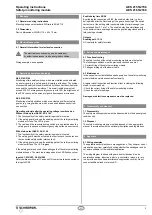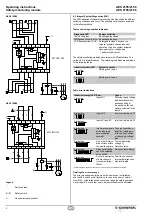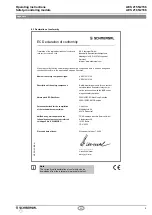
2
Operating instructions
Safety-monitoring module
AES 2155/2156
AES 2165/2166
EN
1.7 Exclusion of liability
We shall accept no liability for damages and malfunctions resulting from
defective mounting or failure to comply with this operating instructions
manual. The manufacturer shall accept no liability for damages resulting
from the use of unauthorised spare parts or accessories.
For safety reasons, invasive work on the device as well as arbitrary repairs,
conversions and modifications to the device are strictly forbidden; the
manufacturer shall accept no liability for damages resulting from such
invasive work, arbitrary repairs, conversions and/or modifications to the
device.
2 Product description
2.1 Ordering code
This operating instructions manual applies to the following types:
AES 215
➀
➁
No.
Option
Description
➀
5
without start-up test
6
with start-up test
➁
.1
110 VAC
.2
230 VAC
.3
24 VAC
AES 216
➀
➁
No.
Option
Description
➀
5
without start-up test
6
with start-up test
➁
.1
110 VAC
.2
230 VAC
.3
24 VAC
Only if the information described in this operating instructions
manual are realised correctly, the safety function and therefore
the compliance with the Machinery Directive is maintained.
2.2 Special versions
For special versions, which are not listed in the order code below 2.1,
these specifications apply accordingly, provided that they correspond
to the standard version.
2.3 Destination and use
The safety-monitoring modules for integration in safety circuits are
designed for fitting in control cabinets. They are used for the safe
evaluation of the signals of positive break position switches for safety
functions or magnetic safety sensors on sliding, hinged and removable
safety guards as well as emergency stop control devices.
Design
The safety-monitoring modules have a dual-channel structure. They
include two safety relays with monitored positive action contacts. The
NO contacts of the relays, which are wired in series, build the enabling
contacts.
2.4 Technical data
Standards:
IEC/EN 60204-1; EN 60947-5-1;
EN 60947-5-3; EN ISO 13849-1;
IEC 61508; BG-GS-ET-14;
BG-GS-ET-20
Start conditions:
Automatic
Feedback circuit available:
no
Start-up test:
AES ...5: no; AES ...6: yes
Pull-in delay for automatic start:
adjustable 0.1 / 1.0 second
Drop-out delay:
< 50 ms
Rated operating voltage U
e
:
110 VAC
230 VAC
24 VAC
Rated operating current I
e
:
0.3 A
Rated insulation voltage U
i
:
250 V
Rated impulse withstand
voltage U
imp
:
4 kV
Thermal test current I
the
:
6 A
Internal electronic fuse:
no
Power consumption:
5 W
Input monitoring:
Cross-wire short detection:
yes
Wire breakage detection:
yes
Earth leakage detection:
yes
Number of NC contacts:
2
Number of NO contacts:
2
Outputs:
Stop category 0:
1
Stop category 1:
0
Number of safety contacts:
1
Max. switching capacity
of the safety contacts:
4 A
Utilisation category to
EN 60947-5-1:
AC-15: 230 V / 2 A
DC-13: 24 V / 2 A
Max. fuse rating:
4 A gG D-fuse
Mechanical life:
20 million operations
LED indication:
Wiring diagram
Ambient conditions:
Operating temperature:
0°C ... +55°C
Storage and transport
temperature:
-25°C ... +70°C
Protection class:
Enclosure: IP 40
Terminals: IP 20
Wiring compartment: IP 54
Degree of pollution:
2
Fixing:
Snaps onto standard DIN
rails to DIN EN 60715
Connection type:
Screw terminals
Min. cable section:
0.25 mm
2
Max. cable section:
2.5 mm
2
, solid strand or
multi-strand lead
(including conductor ferrules)
Tightening torque:
0.6 Nm
Max. cable length:
1000 m with 0.75 mm
2
cable
Weight:
410 g
Dimensions (H/W/D):
110 x 55 x 75 mm
2.5 Safety classification
Standards:
EN ISO 13849-1; IEC 61508
PL:
up to d
Control category:
up to 3
PFH value:
1.0 x 10
-7
/ h; applicable for ap
-
plications with up to max. 50,000
switching cycles / year and max.
80 % contact load. Diverging
applications upon request.
SIL:
up to 2
Service life:
20 years
























